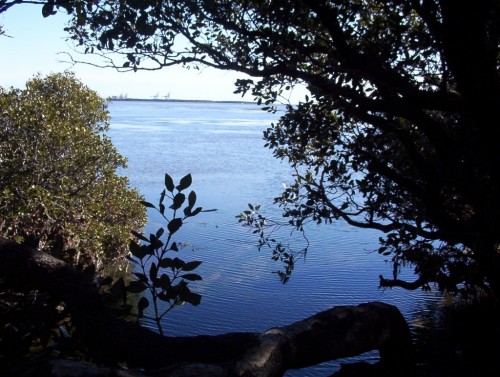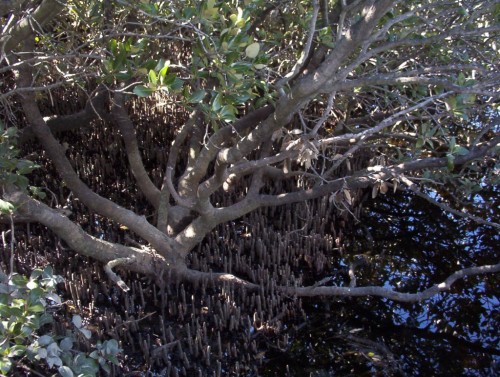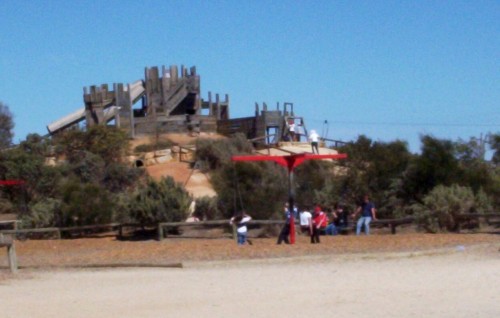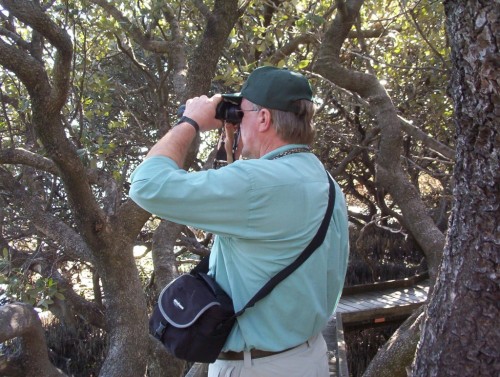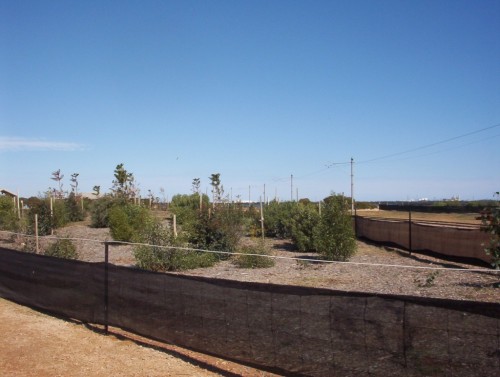Salt Tolerant Plants
An email came today asking for assistance with species that would grow in bore water with high salt readings. This is a difficulty for many in the mallee areas of South Australia and no doubt other parts of the country too. In many cases it becomes trial and error to see what would grow in such a situation, but some lists have been compiled by members of the Australian Plants Society which give a good starting point.
There are some things to consider.
- There is a need to ensure that watering is deep.
- Choose plants from areas which have the same rainfall situation ie same amount of rain, at the same time of year. This is to ensure that plants will get minimum exposure to the high salinity.
- If possible place highly desirable plants near an alternative water source, eg rain water, to get them well established without the saline water.
List of Australian Native Plants with salt tolerance.
1st Line Coast
Ground Covers, Climbers and Low Spreading Plants
Correa decumbens
Eremophila glabra prostrate cerise form
Eremopohila glabra prostrate red form
Grevillea ‘Seaspray’
Isolepis nodosa
Leuocophyta brownii
Rhagodia spinescens
Scaevola crassifolia
Templetonia retusa prostrate form
Shrubs 1-2m
Atriplex cinerea
Callistemon rugulosus
Eremophila calorhabdos
Eremophila glabra (Rottnest Island)
Hakea cycloptera
Olearia axillaries
Templetonia retusa
Westringia fruticosa
Shrubs over 2m.
Atriplex nummularia
Callistemon teretifolius
Hakea drupacea
Melaleuca nesophila
More lists will be available soon.
Australian Native Plants for Seaside Gardens
This is the beginning of my list of plants suitable for seaside plantings. It is a good idea to use hedges or fences as wind breaks against the prevailing sea winds so that more tender plants can be planted on the lee side where they are less likely to be burnt by salt laden winds. Not having experience with this type of locality I am writing from observation, discussions with folk who do garden in this type of area and what I read.
I am choosing plants that are known to be also lime tolerant. My list also reflects drought tolerance. I will also have to do a list for those who do not need to worry about these other aspects.
Australian Native Plants for Seaside Gardens.
Shrubs
Acacia sophorae
Alyogyne hakiefolia
Banksia grandis
Banksia media
Banksia speciosa
Banksia spinulosa
Chamelaucium uncinatum
Correa alba
Correa backhousiana
Correa reflexa
Melaleuca armillaris
Melaleuca huegelii
Melaleuca hypericifolia
Melaleuca lanceolata
Myoporum acuminatum
Myoporum insulare
Myoporum viscosum
Olearia axillaris
Olearia glutinosa
Phymatocarpus porphyrocephalus
Rhagodia candolleana
Ricinocarpus pinifolius
Templetonia retusa
Westringea fruticosa
Seaside Plantings
I haven’t had good health lately and last week ran away for a week to a seaside suburb where I spent time with my sister who was recuperating from an operation. On our walks and drives I was taking particular note of the Australian native plants growing in the gardens. This area has alkaline soil and would be classed as second line coastal.
This is the next list that I need to develop-Â Plants for Coastal areas which also have alkaline soils.
Mangrove Boardwalk
Salisbury City Council manages the Mangrove Boardwalk at St Kilda, SA. There is a good interpretive centre well worth spending time in before embarking on the walk. The information is easy to read by children and there are some interactive displays.
See my husband’s travel blog for more on this unique area.
I did not know that Mangroves (in this case the Grey Mangrove) have a most interesting method of propagation. After fertilzation occurs in the flower, the seed develops in the fruit. When ready to be shed, the ‘seed’ is actually a fully formed ‘seedling’ which will send down a root into the mud. The leaves are already formed. Apparently many are washed out to sea with the out going tides.
In order for the plant to get oxygen, the roots grow vertically from the mud. Some old trees send roots out from trunk and branches. One of the signs made the comment that some of the old trees in the Mangrove forest were probably there when Colonel William Light sailed past at the beginning of colonisation in South Australia.
The walking trail has been designed for wheel chairs and walkers. A small gopher would probably negotiate the trail well also.
St Kilda SA, Mangrove Area
We found ourselves not far from St Kilda, off Port Wakefield Rd. north of Adelaide today. Decided to have the full day off after losing the morning, so continued on to St Kilda. We had heard of the Mangrove Board Walk years ago and never got there. It is great. There is plenty in the vicinity for children to do.
There were children dressed up as pirates storming the ramparts and manning the ‘old wreck’ (maybe fans of ‘Pirates of the Carribean’!) Teenagers and young adults had fun on the big slide and flying fox. There is a nice grassed picnic area, lots of safe places for fishing and of course the board walk. We enjoyed late morning tea there and later, lunch. I always pack a thermos and food when we do things like this. It is much more interesting looking at plants and birds whilst having a cuppa than the four walls of a shop.
This is quite an exposed area of Gulf St. Vincent and plants must withstand the blast of salt winds. One of the toughest plants, obviously planted some time ago, is the old man salt bush, Atriplex nummularifolia. There are new plantings of other species that have been protected by a shade cloth wind break while the plants were small. They are now up above the fence and looking good.
